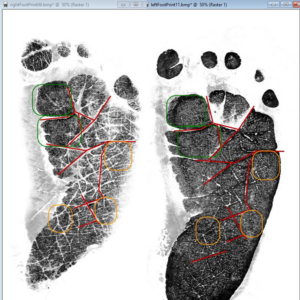🇬🇧 Is it reliable to identify our children at birth in 21st century hospitals?
Some of the problems that were present when I was born back in 1967 have been corrected globally.
However, mistakes or the possibility of maliciously exchanging one baby for another is still a problem around the world today. Not only because of the distress of exchanging one baby for another, but also because of receiving treatments that can be lethal by mistaking one patient for another.

Some of the examples:
- In September 2021, it was revealed that two baby girls had been switched at birth at the San Millán hospital in Logroño in 2002, due to human error1. This case has reopened the debate on the newborn identification system in Spanish hospitals, which is currently based on the combination of a neonatal coding system (mother and baby bracelet and cord clamp with the same number and barcode) and the collection of maternal and umbilical cord blood samples2.
- In August 2021, a Texas couple had a lawsuit filed against a hospital for handing them the wrong baby after delivery, causing them emotional distress and confusion. The hospital admitted the mistake and apologised, but the couple alleges that the staff did not follow proper identification protocols and that the incident could have been avoided.
- In July 2021, a Sri Lankan woman discovered that the son she had raised for 19 years was not hers, but that of another woman who had given birth on the same day in the same hospital. The mistake was discovered when the young boy needed a blood transfusion and it turned out that his blood type did not match that of his mother. DNA tests confirmed that this was a case of baby swapping.
- On Wednesday, December 21, several media outlets in Bulgaria revealed a spectacular baby-swapping story worthy of an Academy Award. The mother reportedly discovered the truth because of her lack of resemblance to the baby she came home with, specifically the eye color of the infant which was darker than what she was expecting.
- In 2017 in India: With DNA report confirming that babies were swapped Read more at:
-
In May 2021, two families in Colombia discovered that their children had been switched at birth at the hospital in La Dorada in 2000, due to medical negligence. The young people, who had met by chance at university, underwent DNA tests that confirmed the mistake. The families have taken legal action against the hospital and the state.
- In April 2021, a hospital in Turkey admitted that it had given the wrong baby to a couple after delivery, causing them great suffering. The hospital realised the mistake when another couple complained that the baby they had been given was not theirs. The hospital apologised to the affected families and offered them psychological support.2.
- In February 2021, a woman in Argentina reported that her baby had been switched with another baby in San Juan hospital in 1975, and that the child she had raised was not her biological son. The woman suspected the mistake when she saw a photo of another man who looked very similar to her and her husband. DNA tests confirmed that this was her real son, and that the other man was the son of another woman who had given birth on the same day at the same hospital.3.
- In January 2021, a hospital in China admitted that it had made a mistake by mixing up the labels on the blood samples of twin babies, resulting in one of them receiving the wrong hepatitis B vaccine. The hospital apologised to the family and offered them financial compensation. The affected baby did not suffer any adverse effects from the vaccine.
Thus, errors in neonatal identification are serious problems that point directly to the identification processes that are carried out globally. Are they safe? Unfortunately, from the examples shown we must say no. They are not. They are sensitive to one error per 10000 births from published data, but we know from other reports:
- According to a study carried out in a neonatal unit of a university hospital in Madrid, the percentage of errors in the identification of a neonate during the hospitalisation period was 0.13%. . This type of error can have serious consequences for the safety and well-being of newborns and their families, and prevention measures based on the use of neonatal coders, collection of maternal and umbilical cord blood samples, and verification of identity prior to any procedure are recommended. Safety of the hospitalised neonate: Approaches and proposals: Recommendations for unequivocal identification of the newborn.
- A study conducted in a US hospital analysed the risk factors associated with newborn identification errors in the neonatal intensive care unit (NICU). The study found that the risk of misidentification was higher for babies with identical surnames, similar-sounding names, or similar appearance. The study suggests that strategies be implemented to improve communication and education of staff and parents about the importance of correct identification.
- A study conducted in a Canadian hospital evaluated the effectiveness of a biometric identification system based on facial recognition of newborns. The study showed that the system was able to correctly identify babies with an accuracy of 99.9%. The study concludes that the system could be a useful tool to prevent baby swapping and improve patient safety.
With the data shown by rigorous studies, it remains today a major problem that can be greatly improved by using technology that can always offer advantages over other more artisanal uses:
Certascantek offers an innovative solution based on the digital scanning of newborns’ footprints, complemented by the capture of security photos and the mother’s fingerprint. This patented and technologically advanced system provides high-resolution images that are stored electronically and can be consulted at any time.
Certascantek has multiple advantages over traditional identification systems, such as:
- It improves the security of hospitals and newborns by preventing possible changes, abductions, natural disasters or abandonment.
- It complies with the latest National Center for Missing and Exploited Children (NCMEC) child safety guidelines and Joint Commission patient identification standards.
- Reduces the risk of human or malicious error by eliminating the use of inks, paper or labels that can be altered or lost.
- Facilitates the use and storage of images by not requiring cleaning, printing or physical archiving.
- Increases the satisfaction of mothers, nurses and medical services by providing an attractive and personalised keepsake with hospital branding and scanner data.
- Enables integration with electronic medical records and other health information systems.

